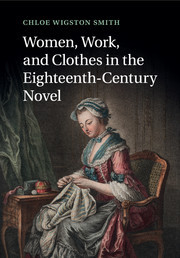Description
Women, Work, and Clothes in the Eighteenth-Century Novel
Author: Smith Chloe Wigston
This book charts the novel's vibrant engagement with clothes, examining how fiction revises and reshapes material objects within its pages.
Language: EnglishApproximative price 30.28 €
In Print (Delivery period: 14 days).
Add to cart
Women, Work, and Clothes in the Eighteenth-Century Novel
Publication date: 01-2016
Support: Print on demand
Publication date: 01-2016
Support: Print on demand
Approximative price 104.26 €
In Print (Delivery period: 14 days).
Add to cart
Women, Work, and Clothes in the Eighteenth-Century Novel
Publication date: 06-2013
269 p. · 18x25.4 cm · Hardback
Publication date: 06-2013
269 p. · 18x25.4 cm · Hardback
Description
/li>Contents
/li>Biography
/li>
This groundbreaking study examines the vexed and unstable relations between the eighteenth-century novel and the material world. Rather than exploring dress's transformative potential, it charts the novel's vibrant engagement with ordinary clothes in its bid to establish new ways of articulating identity and market itself as a durable genre. In a world in which print culture and textile manufacturing traded technologies, and paper was made of rags, the novel, by contrast, resisted the rhetorical and aesthetic links between dress and expression, style and sentiment. Chloe Wigston Smith shows how fiction exploited women's work with clothing - through stealing, sex work, service, stitching, and the stage - in order to revise and reshape material culture within its pages. Her book explores a diverse group of authors, including Jane Barker, Jonathan Swift, Daniel Defoe, Eliza Haywood, Samuel Richardson, Henry Fielding, Charlotte Lennox, John Cleland, Frances Burney and Mary Robinson.
Introduction; Part I. The Rhetoric and Materials of Clothes: 1. The ornaments of prose; 2. Paper clothes; Part II. The Practical Habits of Fiction: 3. Shift work; 4. Domestic work; 5. Public work; Afterword: false parts; Bibliography; Index.
Chloe Wigston Smith is an Assistant Professor in the Department of English at the University of Georgia, where she specializes in eighteenth-century studies. She studied the History of Dress at the Courtauld Institute of Art.
© 2024 LAVOISIER S.A.S.





